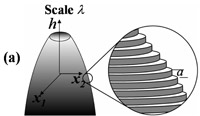The University of Maryland MRSEC grants ended in September 2013 after 17 years of successful operation. This site remains as a history of the center, but will not be actively maintained.
Seed 3: Modeling Elastic Effects on Crystal Surfaces
Senior Investigator
- Dionisios Margetis (leader), Mathematics & IPST

Two-scale picture of crystal surface. Left: The macroscale, where surface height is used. Right: The nanoscale, where steps are evident.
Controlling the evolution of crystal surfaces can play a crucial role in the design and fabrication of novel optoelectronic devices and structures such as quantum dots. The controlling parameters and variables include temperature, deposition flux, external electric field and elastic stress, by which useful patterns on a surface can be created and possibly be manipulated. Modeling and simulating the effects of these controlling factors often lead to predictions that guide future experiments.
Mathematics has a lot to offer and a lot to gain in this context. The major goal of this Seed is to model, analyze and simulate the effects that the interactions between line defects ("steps") at the nanoscale have on the evolution of crystal surfaces at the macroscopic scale. So, the challenge is to reconcile the physical descriptions at two separate scales. At the nanoscale, a reasonable description is provided by a discrete model where steps are viewed as "particles" moving under given motion laws. At the macroscale, the usual, inexpensive description captures the motion of surfaces via Partial Differential Equations (PDEs) for the surface height. The questioned asked in this Seed: How are these PDEs derived from the motion of steps, and what predictions do the PDEs yield? In particular, this Seed focuses on aspects of PDEs that are directly related to elastic properties of steps, e.g., their elastic-dipole interactions. The research also addresses the analysis and simulation of the derived PDEs, which lead to the prediction of interesting surface patterns. These results can indicate how the self-organization of surface structures can be controlled by external parameters such as temperature, electric field and stress.
Highlights
- Fundamentals in Applied Math of Structural Evolution
- For the complete list, see the Highlights page
Publications
Contact Us | Page Last Updated: 05/01/09 | Site Map


